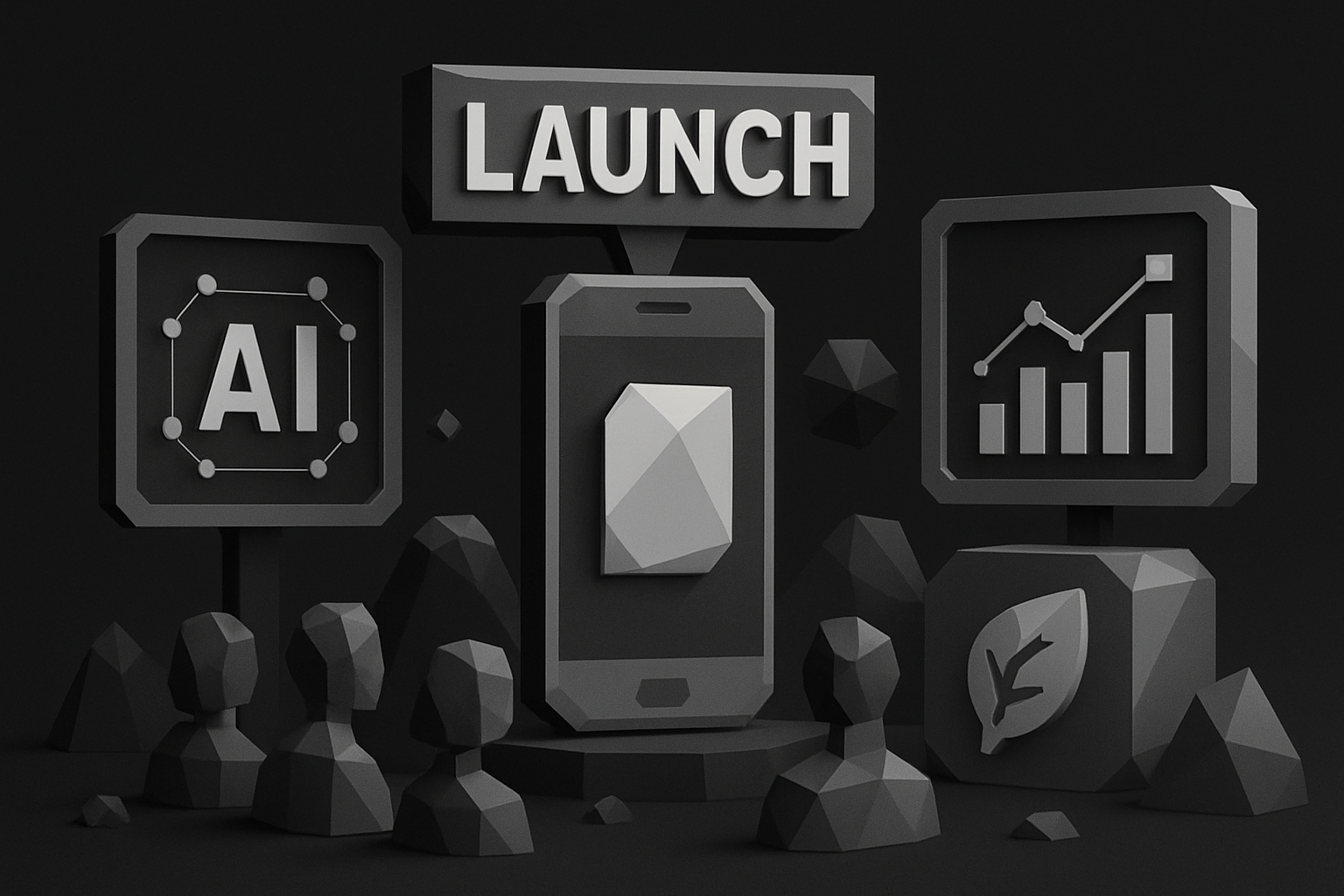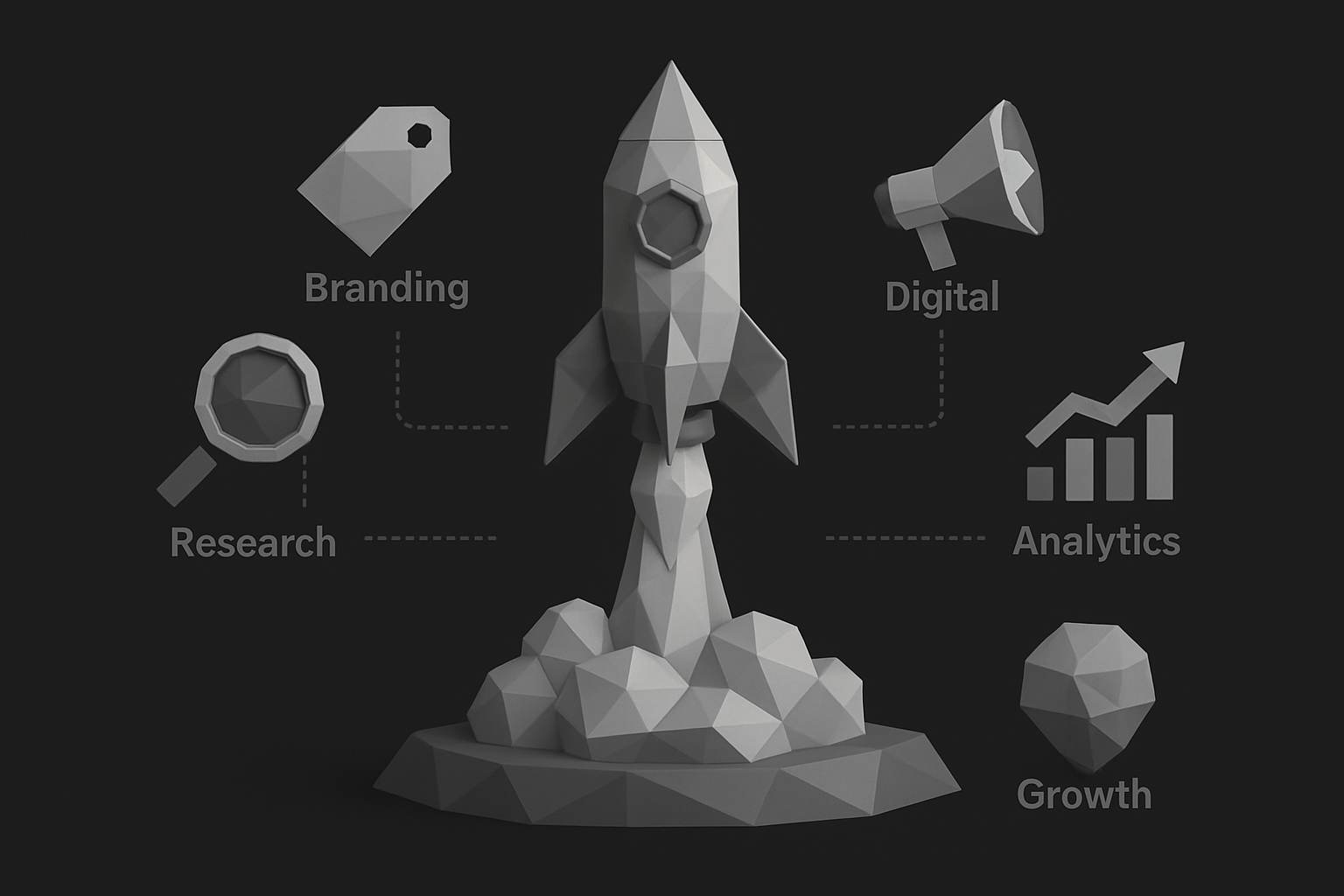Every year, thousands of businesses dream of launching a product, but most never see lasting success. The competition in 2025 is more intense than ever, and only a strategic, step-by-step approach stands a real chance.
If you want your next launch to stand out, you need a proven roadmap. Mastering the 10 essential steps in this guide can dramatically boost your odds of success.
This article breaks down everything you need to know, covering market research, product development, branding, marketing, launch execution, and post-launch improvement. Follow this blueprint to navigate the complexities of launching a product and achieve your goals.
Understanding the 2025 Product Launch Landscape
Launching a product in 2025 means stepping into one of the most competitive and fast-paced markets we’ve ever seen. As innovation accelerates and consumer demands shift almost overnight, the rules for launching a product are being rewritten.

AI Integration and Automation
Artificial intelligence is at the heart of launching a product in 2025. From predictive analytics to AI-driven personalization, smart technology shapes every stage. Businesses now rely on machine learning to forecast trends, automate marketing, and optimize user experiences. AI helps brands spot gaps in the market and respond to feedback in real time, making launching a product more strategic than ever.
Sustainability and Digital-First Strategies
Sustainability is no longer optional—it’s a core expectation. Consumers want eco-friendly products, responsible sourcing, and transparent supply chains. At the same time, digital-first strategies dominate. Companies prioritize online launches, leveraging e-commerce, apps, and virtual events to reach audiences globally. This shift means launching a product requires a seamless blend of environmental responsibility and digital agility.
Evolving Consumer Expectations and Personalization
Today’s buyers expect every interaction to feel tailored. Hyper-personalization, powered by data, is a game-changer when launching a product. Brands gather insights from social listening, purchase histories, and real-time engagement to deliver unique experiences. Meeting these expectations builds trust and loyalty, helping new products stand out.
Omnichannel Approaches and the Power of Data
The rise of digital channels means consumers switch between platforms—web, mobile, social—without missing a beat. An omnichannel approach is essential for launching a product successfully. Brands must ensure consistent messaging and seamless transitions across every touchpoint. Data analytics and real-time feedback loops guide decision-making, letting teams pivot instantly based on customer reactions.
Here's a quick look at the top trends and their impact:
| 2025 Trend | Impact on Launching a Product |
|---|---|
| AI Integration | Drives personalization, optimizes campaigns |
| Sustainability | Builds brand trust, meets consumer demand |
| Digital-First | Expands reach, lowers entry barriers |
| Omnichannel | Delivers cohesive customer experiences |
| Real-Time Analytics | Enables instant optimization and pivots |
Success Stories and Key Statistics
Recent launches show how these trends play out. For example, a tech startup used AI-powered social listening to identify a niche, then rolled out a sustainable product line exclusively online—selling out in days. But the stakes are high: over 30,000 new products hit the market every year, and a staggering 95% fail, often due to poor planning and execution. For more eye-opening data, check out the Top 10 Product Launch Statistics.
Agility, Adaptability, and Compliance
Surviving and thriving when launching a product depends on staying agile. Teams must adapt to feedback, market shifts, and emerging tech. Regulatory and privacy issues are also front and center, especially for digital products. Compliance with evolving data laws is critical to avoid setbacks and maintain consumer trust.
In 2025, launching a product is both more challenging and more rewarding. By understanding these trends and preparing to adapt, brands can confidently move forward and set the stage for a successful launch.
10 Essential Steps for Launching a Product Successfully in 2025
Successfully launching a product in 2025 is no small feat. The landscape is crowded and fast-moving, but with the right blueprint, you can turn an idea into a market hit. Below, we break down the ten essential steps every team must master. Whether you’re a startup founder or part of a larger innovation team, these steps will help you navigate the journey from concept to ongoing growth.

1. Conduct Thorough Market Research
Launching a product without solid market research is like sailing without a map. You need to understand your target audience, competitors, and the overall industry landscape.
Begin by gathering insights through surveys, focus groups, and social listening. Analyze competitor moves and identify gaps in the market. This helps validate whether there’s real demand for your idea.
AI-powered tools can uncover hidden patterns in customer behavior and market trends. By leveraging data-driven decision-making, you reduce the risk of costly missteps. For example, brands that pivoted after discovering unmet customer needs often outperformed those that didn’t.
Remember, 56% of product failures are due to inadequate market research. Make market intelligence your compass when launching a product.
- Use online surveys for broad feedback.
- Engage in competitor analysis to spot opportunities.
- Tap into social media for real-time sentiment.
Launching a product starts with knowing your market inside and out.
2. Define a Unique Value Proposition
What makes your product stand out? Defining a unique value proposition (UVP) is the linchpin for launching a product that resonates.
Start by pinpointing customer pain points. Use frameworks like the Value Proposition Canvas to clarify your product’s benefits. Keep your message crisp, clear, and focused on real customer needs.
Leading brands excel by simplifying their UVP. For example, a fitness app might promise “personalized workouts in 10 minutes a day”—short, memorable, and benefit-driven.
Test your UVP with real users. Refine it until it clicks. A strong UVP not only guides product development but also supercharges your marketing and sales efforts.
- Identify what your product does better or differently.
- Focus on benefits, not just features.
- Validate your messaging with customer feedback.
Launching a product with a compelling UVP increases your chances of capturing attention and driving conversions.
3. Develop a Customer-Centric Product
Designing with the end user in mind is critical when launching a product. User experience (UX) should be at the forefront, with iterative prototyping and feedback loops built in from the start.
Beta testing lets you gather hands-on insights. Many successful products evolved after listening closely to early users. For example, software companies often release MVPs, then rapidly iterate based on feedback.
Accessibility and inclusivity are no longer optional. Build features that welcome all users. Agile methodologies help you adapt quickly, ensuring the product stays relevant.
Did you know 80% of successful launches involve customers during development? For digital products, our Building Digital Products Guide offers a deeper dive into best practices for customer-focused creation.
- Run frequent user tests.
- Prioritize accessibility from day one.
- Iterate quickly based on real feedback.
Launching a product that puts customers first pays off in loyalty and growth.
4. Build a Strong Brand and Messaging Strategy
Branding is your product’s personality. When launching a product, a memorable name, logo, voice, and story set you apart.
Consistent messaging across all channels builds trust. Develop clear brand guidelines and tone-of-voice documents to keep everyone on the same page. Digital tools make asset creation and distribution easier than ever.
Storytelling isn’t just for novels—it’s a powerful way to connect emotionally with your audience. Companies like Apple and Nike have shown how compelling stories can elevate a brand.
Influencer partnerships can amplify your reach. When launching a product, consider working with well-aligned voices to extend your message.
- Create a brand style guide.
- Use storytelling to humanize your product.
- Leverage influencers for greater reach.
Launching a product with a cohesive brand strategy lays the foundation for long-term success.
5. Create a Go-to-Market Plan
A go-to-market (GTM) plan is your launch playbook. When launching a product, outline your sales strategy, marketing channels, pricing, and distribution.
Choosing the right mix of digital and physical channels is key. Timing matters—align your launch with peak demand periods or industry events.
Templates and frameworks can streamline GTM planning. Ensure cross-functional alignment by bringing sales, marketing, and product teams together. Contingency planning helps you navigate unexpected challenges.
Here’s a quick GTM plan checklist:
| GTM Element | Purpose |
|---|---|
| Sales Strategy | Defines how you’ll close deals |
| Marketing Mix | Outlines channels and messaging |
| Pricing | Sets value perception |
| Distribution | Ensures product availability |
Launching a product with a well-structured GTM plan increases your odds of a successful rollout.
6. Build Hype and Pre-Launch Buzz
The countdown to launch is a golden opportunity. When launching a product, pre-launch marketing can drive anticipation and early demand.
Teaser campaigns, waitlists, and influencer outreach are proven tactics. Social media and email marketing keep your audience engaged, while PR can secure valuable coverage.
Consider offering exclusive previews, early access, or limited-time offers to create urgency. Community engagement and user-generated content can amplify excitement.
Products with strong pre-launch campaigns often see up to 30% higher initial sales. Collaborate with partners to extend your reach.
- Launch a teaser campaign weeks ahead.
- Build a waitlist for early adopters.
- Encourage community sharing and buzz.
Launching a product with momentum sets the stage for a strong debut.
7. Prepare for Launch Execution
Execution day can make or break your success. When launching a product, meticulous preparation is vital.
Manage inventory, streamline order fulfillment, and ensure customer support is ready. Develop a detailed launch-day checklist covering logistics, communications, and contingency plans.
Team training ensures everyone knows their role. Use technology for real-time monitoring and troubleshooting. Scalability is crucial—be ready to handle a surge in demand.
First impressions matter. Responsive customer service can turn launch-day hiccups into positive experiences.
- Double-check inventory and fulfillment systems.
- Prepare a backup plan for technical issues.
- Train your team for smooth execution.
Launching a product with thorough planning minimizes surprises and builds trust from day one.
8. Launch and Monitor Performance
When launching a product, execution doesn’t end at go-live. Seamless rollout across all channels is essential.
Set up analytics and key performance indicators (KPIs) to track results in real time. Use dashboards to monitor sales, engagement, and feedback as they happen.
Quick pivots based on launch-day data can save the day. Transparent communication with customers builds credibility, especially if issues arise.
Post-launch surveys and feedback help you spot early wins and challenges. Crisis response plans keep your team prepared for the unexpected.
- Monitor KPIs continuously.
- Respond quickly to feedback.
- Communicate openly with customers.
Launching a product with a data-driven approach lets you adapt fast and maximize impact.
9. Optimize Post-Launch Based on Feedback
Feedback is gold when launching a product. Collect it through surveys, reviews, social listening, and direct outreach.
Analyze responses to identify areas for improvement. Rapid iteration—using A/B testing to refine features and messaging—can lead to significant growth. Companies that listen to users often see products evolve in ways that drive retention and revenue.
Building loyalty requires responsiveness. Statistics show that companies acting on feedback can double customer retention rates.
- Set up regular feedback channels.
- Use A/B tests to optimize features.
- Iterate quickly on user suggestions.
Launching a product is just the start; ongoing optimization keeps you ahead of the curve.
10. Scale and Sustain Growth
The final step in launching a product is scaling up. Expand your reach by targeting new segments, geographies, or channels.
Operational scalability—through automation and streamlined processes—prepares you for rapid growth. Consider partnerships and collaborations to accelerate momentum.
Ongoing marketing and customer engagement are essential. Schedule regular performance reviews to identify opportunities for strategic pivots. Continuous innovation is the hallmark of products that sustain long-term growth; 70% of such products invest in R&D and process improvements.
- Explore new markets and partnerships.
- Automate repetitive tasks for efficiency.
- Revisit strategy regularly for fresh opportunities.
Launching a product is a journey, not a destination. With the right steps, you can achieve lasting success.
Common Pitfalls and How to Avoid Them
Launching a product in today’s market can feel like navigating a minefield. Despite meticulous planning, many teams stumble into familiar traps that derail even the most promising launches. Statistics show that up to 95% of new products fail, often for avoidable reasons. Recognizing these pitfalls early is essential for anyone serious about launching a product with confidence.

Common Mistakes in Launching a Product
Several traps consistently undermine product launches:
- Skipping or rushing market research
- Underestimating established competitors
- Poor timing with seasonal or market trends
- Failing to define a unique value proposition
Each of these mistakes can severely impact your chances of launching a product successfully. Without a solid understanding of your audience and competitors, your offer may miss the mark or get lost in the noise.
The Dangers of Feature Creep and Ignoring Feedback
Trying to wow customers with too many features often backfires. Overcomplicating your product can overwhelm users and dilute your core message. Equally hazardous is ignoring user feedback—products that don’t evolve based on real-world input rarely achieve traction.
Consider this table of pitfalls and outcomes:
| Pitfall | Typical Outcome |
|---|---|
| Feature overload | User confusion |
| No feedback loop | Low adoption |
| Unclear product positioning | Weak market response |
When launching a product, balance ambition with clarity and always keep the user at the center of development.
Team, Resources, and Execution Risks
Resource allocation and team alignment are critical. Teams that lack clear roles, communication, or sufficient funding quickly run into execution issues. Delays, missed deadlines, and quality lapses often result from these internal missteps.
Real-world examples abound of launches that faltered due to mismanaged teams or stretched resources. For instance, products that failed to scale support operations during launch periods suffered lasting reputational damage.
Actionable Tips to Avoid the Most Common Pitfalls
Avoiding pitfalls starts with proactive risk management. Here are proven strategies:
- Use phased rollouts or pilot programs to gather early insights.
- Invest in robust testing before going live.
- Foster cross-functional communication to keep everyone aligned.
- Regularly review feedback and pivot quickly when needed.
For more expert analysis on overcoming launch challenges and streamlining team collaboration, check out Smooth Product Launches Are Simpler Than You Think.
Learning from both successes and failures is crucial when launching a product. Build in review cycles, celebrate wins, and treat setbacks as opportunities to refine your approach. This commitment to growth will help you navigate the complexities and maximize your chances of launch success.
Future-Proofing Your Product Launch Strategy
Staying ahead in 2025 means anticipating changes before they happen. Emerging trends like AI-driven personalization, sustainability, and immersive experiences such as AR and VR are redefining what it takes to succeed when launching a product. Brands that adapt quickly to these shifts will have the edge.

Trends Shaping Future Product Launches
Launching a product in the coming years means embracing powerful new trends. AI is now central to understanding customer needs and delivering personalized experiences at scale. Sustainability has moved from a buzzword to a baseline expectation, with eco-friendly materials and ethical sourcing influencing buyer decisions.
Immersive technologies like AR and VR are transforming how customers engage with new products. For example, virtual try-ons and interactive demos provide hands-on experiences before purchase. Brands that tap into these advances will stand out when launching a product.
Building Agility and Customer-Centricity
Agility is more than a buzzword—it's a necessity. Rapid shifts in technology and consumer behavior mean brands must be ready to pivot quickly. Building a culture of ongoing learning helps teams stay ahead of the curve.
Customer communities play a key role here. By involving users in co-creation and feedback loops, brands can adapt their offerings in real time. This approach not only improves satisfaction, but also builds lasting loyalty. When launching a product, fostering an agile, customer-centric mindset is essential for long-term relevance.
Leveraging Data, Technology, and Continuous Innovation
Data and technology are the backbone of future-proof strategies. Real-time analytics enable smarter decisions, while automation streamlines marketing and operations. Brands that invest in the right tools can iterate faster and spot new opportunities for growth.
For a deeper dive into practical strategies, check out A Complete Handbook for Product Launches in 2025, which covers the importance of leveraging technology and adapting plans. Regularly reviewing your process and exploring the best digital marketing tools can help you stay one step ahead when launching a product in a fast-changing landscape.
If you’re feeling inspired to put these 10 essential steps into action and take control of your own product launch journey, you’re not alone. Building a digital product business can seem overwhelming, but with guidance from CreateSell and insights from pros like Modest Mitkus, you don’t have to figure it out on your own. Whether you’re ready to move from idea to execution or just want to see what’s possible for you in 2025, you can start today and make your vision real—one step at a time.
Get Started